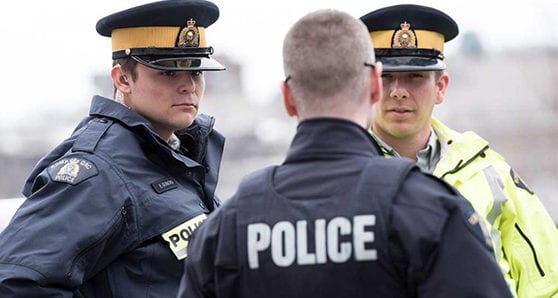 We’re in the era of predictive policing, geo-profiling and crime prevention – carding 2.0 – and need to ask the tough questions about what that means.
We’re in the era of predictive policing, geo-profiling and crime prevention – carding 2.0 – and need to ask the tough questions about what that means.
Understanding and safeguarding personal freedom and civil rights is more critical than ever. The pace at which artificial intelligence is being developed and incorporated is far outpacing the regulatory and ethical frameworks required to control their unintended and deliberate intrusion and erosion of hard-fought for civil liberties.
One of the most contentious policing practices involves the random stopping and questioning of citizens and the subsequent documentation of the information, including name, race, descriptors of clothing, location, reason for the interaction and names of any associates. More commonly known as contact cards, their genesis traced to a number of precursors.
First, as policing became increasingly decentralized during the 1970s, officers were increasingly taken out of cars and assigned to foot and bicycle patrols. The intention was to phase away from drive-by policing to face-to-face neighbourhood patrols or community policing.
Officers would have to take the time to build relationships to earn trust, to create opportunities for citizens to want to share information with them.
This new style necessitated new ways of monitoring and evaluating font-line performance.
It was difficult for supervisors and managers to assess what their officers were doing. How could you confirm that an officer at a community barbecue had actually spent time effectively engaged in establishing meaningful community contacts?
The contact card was perfect. It accounted for how many individuals officers had spoken to and with whom they had developed useful relationships.
It’s not unexpected that as an officer’s contacts with citizens increased, so did their ability to come into contact with potentially wanted persons. That quickly demonstrated the usefulness of contact cards.
As officers sought assignments to coveted specialized units or promotion, contact cards helped demonstrate their commitment to hard work and cultivating information sources. And the potential for cards to identify wanted persons improved their ability to arrest and charge offenders.
Intelligence-led policing emerged during the 1970s and ’80s.
Prior to the 1970s, officers had fewer resources for identifying potential suspects and witnesses following major crimes.
Following a shooting in a crowded public place, for instance, it was difficult to create a list of potential witnesses and-or suspects without stopping and noting the contact information of as many people as resources would permit.
Carding provided a more direct and reliable tool for documenting witness and suspect information, adding to other tools such as parking tickets issued near the scene, or photographs taken by unsuspecting people. Contact cards offered a rich and verifiable tool to record information about people in the area or known to frequent areas of crime scenes.
The information entered into police databases would become an important source of intelligence that could be used at future crime investigations – or that was one justification.
So how did carding lose legitimacy?
Recording information about people of interest, both positive and negative, was intended to allow officers to become familiar with people they met daily.
But how that information was recorded and used poses a challenge to the civil liberties of a democratic society. Contact cards, as intelligence information, have implications that go beyond building relationships.
Intelligence includes information about who frequents an area, when certain individuals are likely to be present, their associates, patterns of movement across neighbourhoods, clothing descriptions, tattoos and a whole host of other similar data.
The usefulness of contact cards quickly surpassed their value for facilitating social contact, while raising concerns about how often and who was being stopped and questioned.
Officers initially only submitted contact cards occasionally. However, when multiple officers were assigned to an area, each made their own contact card.
From the officers’ perspective, this was good policing and if a person didn’t have anything to hide, there would be no reason to resist contact.
But from the citizens’ perspective, this meant repeated contacts about the same information. Along with being annoying, the community saw it as indicative of incompetence and at worst amounted to harassment.
Furthermore, overeager officers rewarded by effective arrests and its collateral benefits – recognition, overtime, and court pay – were encouraged to push the limits of stopping and investigating potential suspects.
Increased arrests also reflected positively on their department or services. In fact managers and chiefs during the 1980s routinely referred to counting ‘lines’ – the numbers of arrests and charges laid as an indication of performance. It’s not difficult to imagine how this evolved into ‘stop and frisk,’ and has been corrupted into the dysfunctional tool that has resulted in significant loss of police legitimacy.
Concern arose from the renewed importance of carding during the era of zero-tolerance policing in the 1980s. Crime, particularly violent crime, was endemic across the U.S. and parts of Canada, fuelled by the proliferation of crack cocaine.
That led to the declaration of a war on drugs and the establishment of specialized drug squads. The rhetoric of zero tolerance and the institution of mandatory sentences further fuelled the importance and abuse of carding.
Tough-on-crime politics contributed to an erosion of the purpose of carding. And that led to a substantial erosion of trust, particularly with minorities and marginalized segments of society.
Overtly, carding results in the temporary detention, perceived or implied, of citizens without cause or authority. But detention is only supposed to be exercised when there’s due cause.
So public concerns and challenges by civil rights advocates have succeeded in bringing focus to the abuses and illegitimate application of carding.
But many of the fundamental issues remain.
Officers most often get into trouble not because of a deliberate pursuit to abuse, but because they have difficulty reconciling the grey areas of policing. What do you do when civil liberties and police suspicion overlap? The experiences of front-line officers are complex and challenging, and laws and policies don’t always define clear and concise courses of actions.
Carding was never based on statutory law authorizing powers to stop or detain citizens. It was simply a means to record information following either a voluntary engagement with a member of the public or an authoritative detention based on a legitimate investigation.
We need to bring greater focus on the covert processes related to gathering public information:
- Where does the data end up?
- Who has access to it?
- How long is it retained?
- Who gets to make decisions about its relevance, integrity, control and sharing?
Police managers are quick to try to demonstrate the importance of carding using extremely limited data to showcase instances where it was useful in solving serious crimes.
But millions of cards were useless.
And what assurances can citizens have that some officers didn’t submit fictitious observations and intelligence reports simply to bolster their performance or for some other ulterior motive?
The improper application of carding has resulted in significant harm to police-community relations, especially within marginalized communities.
The rollback of carding has resulted in a sense among front-line officers that they no longer have the authority to approach and question suspicious individuals. They believe they’re more likely to be subject to public complaints if they exercise initiative. And they believe they’re particularly vulnerable when dealing with persons of colour.
The end of carding, however, is not about to cease the gathering of information. Instead, it will now be gathered and incorporated into police intelligence data bases without the knowledge of the person.
People of colour, especially young males, have been far more likely to be carded than any other segment of society. This should raise two questions.
• Why is this the case? Is it because of systemic racism, and if so is the systemic racism so endemic that it has not been mitigated by screening at the time of recruitment of potential officers, the extensive training and oversight processes?
If so, we have an even larger problem than we might have imagined.
• If bias is not systemic, and even if there is some racism and abuse, is the overwhelmingly disproportion of carding of persons of colour an indication of issues beyond policing? Has society simply disadvantaged certain segments and then placed authoritative controls over them that reflect the collateral dysfunctions?
There appears to be a renewed interest in tough-on-crime policies.
But it’s a false proposition that you can stop and arrest your way out of crime. Proactive arrests represent only a small portion of arrests. Most are reactive, following an incident or information from citizens.
Employing more police officers will undoubtedly increase a sense of safety within the community, and provide some deterrence for as long as the officers are present.
But it will not – given the experience of the last several decades of community policing – eliminate or erode crime over the longer term.
The United States incarcerates more of its citizens than any other country and despite its sustained tough-on-crime policies, it remains one of the most violent societies.
Meanwhile, carding has been replaced by even more draconian technological strategies. We are now subject to a broad surveillance system. Facial recognition technology, traffic cameras, closed circuit surveillance cameras, police worn body cameras, in car cameras, and drone surveillance are just a few of the new tools for collecting intelligence. And the resulting intelligence reports are never brought to the attention of the subject.
There’s no transparency or accountability for how this information is vetted, or assessed for accuracy, relevance and/or reliability.
The most striking example is the application of artificial intelligence towards predictive policing – law enforcement agencies call it PredPol. The often-subjective analysis of data is used to predict locations, times and types of crimes expected to be committed; and even who is expected to commit the crime.
An exponentially-expanding archive of intelligence data emanates from multiple surveillance sources, both public and private sources.
Most of us will never know how this data is used, where it’s retained, for how long, if and how it’s shared, how it impacts our security assessment, and who determines the relevance of the data.
Information remains subjective, at least until it’s tested by external oversight such as a trial. But by then, even if the information was inaccurate or unrelated, the damage to a person’s reputation is done.
So the oversight concerns about carding remain and those responsible for accountability are no further ahead than they were four decades ago.
The pace at which artificial intelligence is being developed and incorporated far outpaces the regulatory and ethical frameworks required to control their unintended and deliberate consequences.
We need to ask the tough questions about what carding 2.0 means to policing and society.
Anil Anand served as a police officer with a Canadian service for 29 years in a variety of roles, including being assigned to Interpol. He has a master of law degree, as well as an MBA, and has taught criminology and community policing courses. His book Mending Broken Fences Policing, looks at the role of contemporary policing in modern society.
Anil is a Troy Media Thought Leader. Why aren’t you?
The views, opinions and positions expressed by columnists and contributors are the author’s alone. They do not inherently or expressly reflect the views, opinions and/or positions of our publication.


